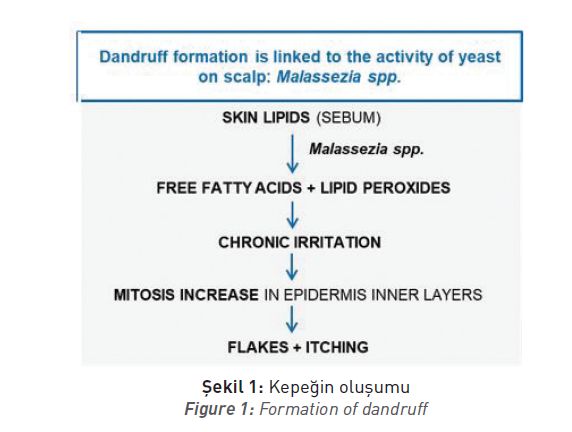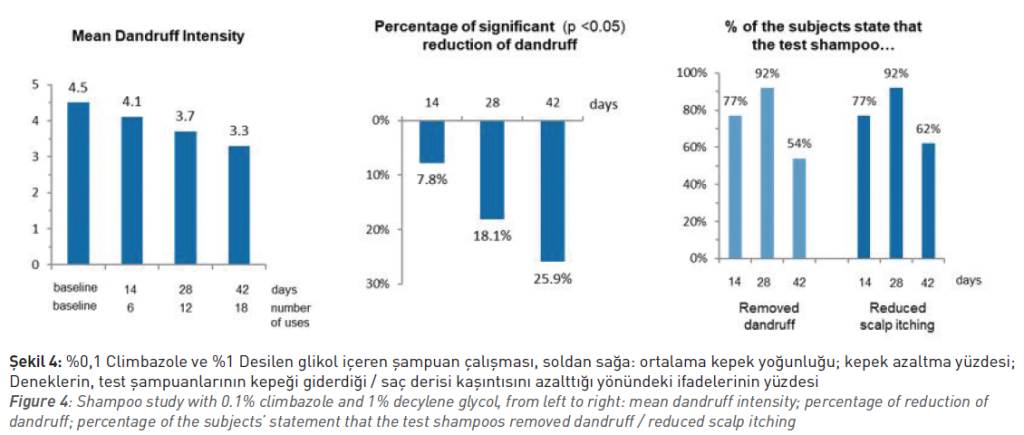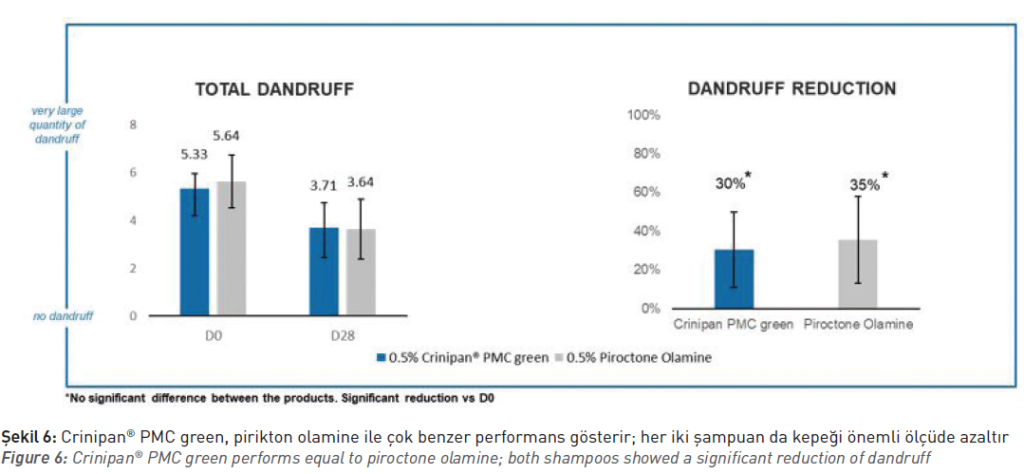Introduction
Zinc pyrithione is one of the most frequently used ingredients in dandruff control. Its ban from the European cosmetic market1 is a hot topic and changes the hair care market drastically. Manufacturers of anti-dandruff products around the world face the challenge to find suitable alternatives that meet changing regulatory requirements as well as growing consumer awareness.
Dandruff is a common scalp condition affecting more than a third of the global population. From China to Germany to Brazil, from Gen Z to Millennials to Baby boomers and regardless of gender, dandruff is considerably affecting consumers’ confidence.
Representative market reviews2 reveal that the vast majority of people with dandruff are looking for natural solutions and for products that will leave the hair smooth and that are not irritating the scalp. In this article we want to discuss how dandruff is formed and present suitable future-proof solutions to keep it under control.
Dandruff Formation
There are different reasons why flakes can appear on the scalp. Not always easy to differentiate from dry scalp, dandruff typically is the result of an oily scalp leading to the overgrowth of Malassezia, a fungus feeding on sebum overproduction (Figure 1)3.
Malassezia is naturally part of the scalp microbiome of most healthy humans.4 Until today, it is still not fully explored why some people develop dandruff and others do not. It seems that genetics play a role along with environmental factors like pollution, an intense cleansing routine, stress, and cold weather.
The first choice to treat dandruff symptoms is typically the use of anti-fungal actives. This is based on the conclusion that the healthy microbial equilibrium is disturbed on flaky scalp due to an overgrowth of certain microorganisms.


On the other hand, flaky scalp is not always linked to Malassezia and sebum overgrowth. In that case, formulations should focus on combining caring effects with anti-dandruff activity.
Crinipan® AD (climbazole), a Traditional Antimicrobial Option
Antimicrobial have been the most commonly used choice to target dandruff. These ingredients control the overgrowth of microorganisms on scalp, more specifically the Malassezia genus which is linked to dandruff formation.
Among these solutions, the most known are: climbazole (Crinipan® AD), zinc pyrithione (ZPT), and piroctone olamine (PO), which are widely used and commonly known for their efficacy in reducing dandruff.
The regulatory change that prohibits the use of ZPT in the EU, effective since March 1st, 2022, has stopped the use of this ingredient in the European market, and expected to also affect the global market in the coming years as a global decrease of the number of products launched with zinc pyrithione has been observed in the past three years (Figure 2).
According to current European law, climbazole may be used in rinse-off anti-dandruff6 shampoos up to 2% (Annex III/310) but has lower use levels in other applications (Annex V/32).7 These limits have been in place since 2019.
In the past, a commonly accepted maximum use level of up to 0.5% across the whole range of cosmetics was common practice. This level is still valid in some countries today, e.g., in China.
Symrise has performed several in vivo studies, comparing the effectiveness of the three traditional anti-dandruff. One of these investigations compared the efficacy of 0.5% climbazole versus 0.5% ZPT in an identical shampoo base. Both, dandruff score (1 [no dandruff] to 6 [extreme]) and hair greasiness (1 [non-greasy] to 6 [extreme]) were evaluated by 3 experts.
This 6 week evaluation was conducted on 30 subjects, half of them using a shampoo containing climbazole and the other half a shampoo with ZPT. The conclusion of this study
showed that climbazole significantly reduced dandruff within the period of 42 days of treatment, having similar effectiveness to ZPT as seen in Figure 3.
In addition, climbazole showed a stronger reduction of greasiness on scalp vs. ZPT, additionally helping against new dandruff formation (Figure 1 and Figure 3).

SymClariol®, a Globally Compliant Multifunctional
SymClariol® (decylene glycol) is used around the world as cosmetic ingredient that tackles multiple aspects of personal hygiene. The emollient´s lipophilic nature and antimicrobial profile make it an ideal multifunctional ingredient for cosmetic hygiene products from scalp to toe. For hair and scalp care applications its recommended use level is up to 2%.
The performance of the molecule on scalp in helping to reduce sebum as well as dandruff has been demonstrated in a study from Beauty Hi-tech Innovation Co., Ltd.8
A study done by Symrise, which was conducted on 13 subjects, confirms the efficacy of shampoos containing a reduced dosage (0.1%) of climbazole combined with 1% of SymClariol® (decylene glycol).
The subjects washed their hair 3 times per week with the test shampoo. After 42 days of use, the dandruff score decreased significantly, and the subjects stated that the shampoo helped in reducing scalp itching (Figure 4).9

These data suggest that manufacturers can either combine decylene glycol with an established anti-dandruff like climbazole or even rely on SymClariol® alone. In fact, combining different anti-dandruff ingredients in cosmetic formulations is a very common practice.
For instance, current market products from L’Oréal in India contain salicylic acid and zinc pyrithione and Unilever in China uses a combination of climbazole with salicylic acid.10,11 The combination of ingredients can be leveraged to boost the overall anti-dandruff efficacy of the hair care product. This was shown in a study from Beiersdorf, where a combination of 0.5% climbazole and 0.5% piroctone olamine in a shampoo reduced dandruff more thoroughly than a shampoo with 1.0% zinc pyrithione alone.12
Crinipan® PMC green, a Naturally Derived Easy-to-handle Solution
Crinipan® PMC green (propanediol caprylate) has been introduced to the market in 202013 as the next generation of anti-dandruff from natural origin. This ester represents a new mode of action with a targeted release of an ingredient: Malassezia is not able to produce the fatty acids needed for growth and to build the cell membrane.
The yeast release lipases (enzymes) to cleave triglycerides contained in the scalp’s sebum, into alcohol & fatty acids. Instead of the scalp sebum, Malassezia cleaves the ester into caprylic acid and propanediol (Figure 5).
While caprylic acid has direct anti-fungal properties, the application of the propanediol ester masks the strong smell of caprylic acid and brings other beneficial properties.

Crinipan® PMC green showed comparable efficacy to the benchmark climbazole, with a significant reduction of dandruff when used at 0.5%.14 To demonstrate the efficacy of propanediol caprylate in comparison to piroctone olamine in reducing dandruff, a shampoo study had been conducted over a period of 28 days on 21 volunteers with greasy scalp.
Non-adherent and adherent dandruff were evaluated by a dermatologist using a scale from 0 (no dandruff) to 5 (very large quantity of dandruff) over the whole scalp. Therefore, the resulting total dandruff score (adherent + non-adherent) scales from 0 to 10.
The shampoos contained either 0.5% propanediol caprylate or 0.5% piroctone olamine and were used 3 times per week. After 28 days, both shampoos showed a significant reduction of total dandruff flaking. There was no major difference between the two shampoos which clearly confirms the excellent efficacy of Crinipan® PMC green.

In addition to significantly reducing dandruff, further studies have shown that Crinipan® PMC green supports a healthier scalp microbiome and also provides further benefits like softer skin, shinier hair as well as ease of detangling and helping to reduce sebum.15 Crinipan® PMC green is recommended to be used up to 1.0% in cosmetic applications.
A great advantage of this material is that it is a liquid which is easy to handle as it does
not require a lot of energy during the production process of the cosmetic product: no heating and no strong mixing are necessary to solubilize the material.
Crinipan® ADS, an All-in-one Liquid Solution
The challenge that some formulators might face when using conventional antimicrobial ingredients like ZPT, PO or climbazole is their solid form. In order to solubilize them into the formulation in most cases energy like heat or at least a prolonged stirring time are required.
To overcome such challenges, formulators may opt to use Crinipan® ADS, a liquid blend which contains climbazole as well as phenoxyethanol, decylene glycol, and 1,2-hexanediol.
In addition to limiting the overgrowth of Malassezia thanks to its anti-dandruff climbazole, this liquid all-round solution is also successful in providing a complete preservation system on top when used at 1.5% in a shampoo formulation.16,17
Conclusion
The zinc pyrithione ban has already hit the European market and is expected to affect the global market step by step. There is a wide palette of alternative anti-dandruff solutions available that formulators can utilize.
From the most traditional antimicrobial solutions like Crinipan® AD to ingredients that are easier to handle like Crinipan® ADS which adds the benefit of also completely preserving the shampoo formula in just one step. On the other hand, Crinipan® PMC green clearly represents the future of dandruff control: a natural derived and easy-to-handle solution supporting healthy scalp microbiome by an entirely novel and innovative mode of action.
Due to its China compliance, SymClariol® (decylene glycol) is an additional option particularly for applications targeting global markets. The combination of more than one technology remains a common practice to aim for an enhanced performance of the hair care formulation, providing multiple benefits.
References
1 COMMISSION REGULATION (EU) 2021/1902 of 29 October 2021 amending Annexes II, III and V to Regulation (EC) No 1223/2009 of the European Parliament and of the Council as regards the use in cosmetic products of certain substances classified as carcinogenic, mutagenic or toxic for reproduction and published in the Official European Journal on Nov 3, 2021. It took effect in March 1st, 2022: https://eur-lex.europa.eu/legal-content/EN/TXT/PDF/?uri=CELEX:32021R1902
2 Symrise CICS database 2016, 2018, 20-22 countries; Scalp Care Exploration Study 2020, 5 countries
3 American Academy of Dermatology Association. Accessed 11.04.2022 https://www.aad.org/public/everyday-care/hair-scalp-care/scalp/dry-scalp-conditions
4 Findley K., Oh J., Yang J., Conlan S., Deming C., Meyer J., Schoenfeld D., Nomicos E., Park M. (2013). Topographic diversity of fungal and bacterial communities in human skin; Nature, 498 (7454)
5 Mintel. Accessed January 2022 https://www.gnpd.com/sinatra/shared_link/b9cb7b39-8f45-46b2-b181-aaeec7ee40e5
6 Anti-dandruff from a European point of view; subject to differing legislation depending on the region: I.e. propanediol caprylate, climbazole and piroctone olamine are not approved as anti-dandruff actives by the US FDA drug monograph.
7 COMMISSION REGULATION (EU) 2019/698 of 30 April 2019 amending Annexes III and V to Regulation (EC) No 1223/2009 of the European Parliament and of the Council on cosmetic products. https://eur-lex.europa.eu/legal-content/EN/TXT/?uri=CELEX%3A32021R1902&qid=1635933838171
8 Lin X., Nomachi A. and Yang J., (2019). Rise to the Top: decylene glycol for Scalp Health and Care; Cosmetics & Toiletries, June 3rd, 2019
9 Schmaus G., Lange S. (2007). EP20638553B1, Use of c10-c14-alkanediols in the preparation of a composition for the prophylaxis and/or treatment of malassezia-induced dandruff formation and compositions comprising c10-c14-alkanediols.
10 Mintel, L’Oréal anti-dandruff shampoo, L’Oréal Paris. July 2022 – https://www.gnpd.com/sinatra/recordpage/8905265/from_search/pAr7fUjaCH/?page=1
11 Mintel, Clear anti-dandruff shampoo, Unilever. July 2022 – https://www.gnpd.com/sinatra/recordpage/5544185/from_search/1a0BGGdCbL/?page=1
12 Schmidt-Rose T., Brarcn S., Fölster H., Hillemann T., Oltrogge B., Philipp P., Weets G., Fey S. (2011). Efficacy of a piroctone olamine/climbazole shampoo in comparison with a zinc pyrithione shampoo in subjects with moderate to severe dandruff; International Journal of Cosmetic Science, 33, 276-282
13 Genrich F., Koch C., Lange S., Bugdahn N., Schmaus G. Next Generation Dandruff Control. SOFW-Journal 146 8-13. December 2020
14 Genrich, F., Nordzieke, S. (2021). Shaping the Future with Green Dandruff Control; Euro Cosmetics 29, 16-18.
15 Genrich F., Koch C., Massironi M., Thomaz F. Propanediol caprylate: Shifting the Microbiome, Sebum Levels and Classic Approach to Dandruff. Cosmetics & Toiletries Vol 136; No. 6, 44-51. June 2021
16 Genrich F., Pungitore S., Lange S., Pesaro M. (2018). Modern protection for shampoos; Pharmaceutical & Cosmetic review Vol 45; no. 2, 15-17
17 EP2589291B2, CN103083196A, (2012). Synergistically active ternary anti-microbial mixtures; Symrise
Authors
Laura Meunier, Dr. Florian Genrich
Cosmetic Ingredients Division, Category Skin Protection
Symrise AG, Germany
Dr. Steffen Nordzieke
Global Innovation Cosmetic Ingredients
Microbiology Research
Symrise AG, Germany
Translation and Compilation
Tuğba Bayazıt Application Technologist / Team Leader AMET
Symrise





